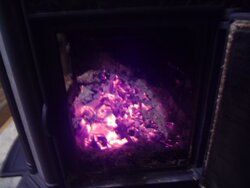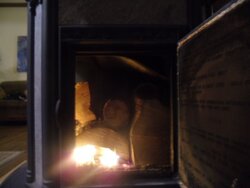I've been in Maui for three weeks. Got back home late Tuesday night. Person who was home sitting had a totally plugged cat, with predictable results. Cleaned the cat, loaded the firebox to a comfortable height with 16 inch and shorter maple uglies. lots of air space. used a supercedar as it was a cold start....within five minutes cut air in half, five more minutes engaged cat, shortly shut air completely. Home quickly went to 74 degrees in stove room (16 x 46 room). Twelve hours later too many coals to reload, stovetop over 300. Opened air for a few hours, then reloaded. Reloaded again late Wednesday night, and about 9 AM Thursday. Temp at all times above 70 in stove room, about 64 on the second floor, somewhat cooler on the third floor. Leaving at 10:30 Thursday for a few days, so reloaded when entire firebox covered about two to three inches deep with very active coals. Wood was fully engaged really quickly, cooktop split within ten minutes of loading, soapstone top temp 250 degrees, exterior reading double wall flue temp (have to install the probe!) 300 degrees...much higher than my usual 150 to 200 degrees.
My recommendation: Don't load on lots of coals. Woodstock is sending me a shield and new cooktop.
I think we should probably all use a shield for the cooktop. Cooktop is relatively thin iron, has deep flanges on the bottom, and I believe that the cast iron is easily capable of getting too hot too quickly to safely expand.
I easily, with ten minutes spent starting the fire, get a 12 plus hour fire with no further tending, air completlely closed in these cooler temps, using largish uglies...quite a few need manoeuvering to get throught the door. Toss smaller wood in also... generally well less than 50% full re volume, on average about 2/3 full in terms of height, but not at all tightly packed, but large splits. I just make sure when I split that the pieces will fit through the door. Stovetop temps may get to 420 or so(although they are usually in the 325 range) , and remain above 300 in excess of the twelve hours. Large home is comfortable. Lots of windows, curtains closed as soon as sun sets.
I find this stove very easy to use, and to regulate output. Except when deliberately burning with very small fires, get way more heat than the Fireview.
To a point mentioned above, Woodstock has tested this stove with wet wood, and found little difference in output and efficiency. Not suggesting using wet wood, just don't think that explains the vast difference in results. I think it is split size that explains differing burn times. I consider 2-3 inch splits kindling, shoulder season wood for small fires. My stove with much of that would burn hot and fast, and burn down to coals quite quickly.
I don't know if I will ever really use much 20-22 inch wood (other than rounds up to about 4-5 inches in diameter) because of the difficulty for me of loading. My large splits at 16 to 18 inches are heavy. Adding 20 % to the length may make the wood too heavy to easily load. I'm getting as much burn time, and as much heat, as I need with 16-18 inch long 8-10 inch splits. I have about 1/3 cord of dry maple split to 20-22 inch, and will see at a time of cold start if I can handle loading with it, (once the temps are really cold ) .








